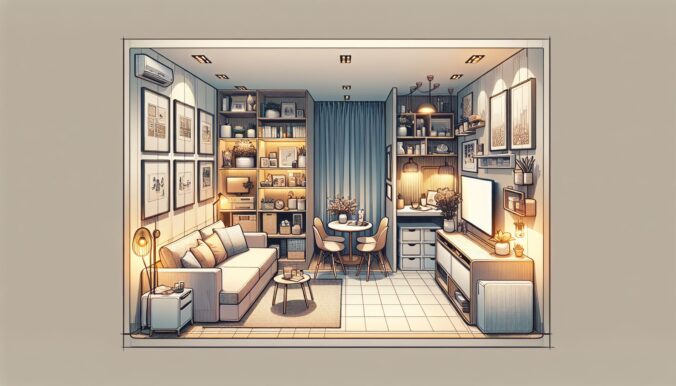In today’s day and age where living spaces are becoming increasingly smaller, it is essential to make the most out of every square inch you have. Whether you are living in a studio apartment, a tiny house, or just have a small room in your home, there are numerous ways you can optimize the space you have and make it feel bigger and more functional. In this blog post, we will explore some practical and budget-friendly tips and strategies for maximizing small spaces in your interior design.
1. Declutter and Organize
The first step in efficiently utilizing a small space is to declutter and organize your belongings. Get rid of things you no longer need or use, and find creative storage solutions for the items you want to keep. Invest in storage bins, baskets, shelves, and organizers to help keep your space neat and tidy. By decluttering and organizing your space, you will not only make it look bigger but also make it easier to find things when you need them.
2. Use Multi-functional Furniture
When working with limited space, it is crucial to choose furniture that serves more than one purpose. Look for multi-functional pieces such as a sofa bed, a coffee table with storage, or a dining table that can be folded down when not in use. This way, you can maximize the functionality of each piece of furniture and save space in the process. Additionally, consider furniture with built-in storage options, such as ottomans that open up to reveal extra storage space.
3. Utilize Vertical Space
In a small room, every inch of space counts, including the vertical space. Make use of your walls by installing shelves, hooks, and racks to store items off the floor. Floating shelves are a great way to display decorations and free up floor space. You can also hang curtains close to the ceiling to create the illusion of higher ceilings and make the room feel more spacious. Don’t forget to utilize the back of doors and cabinets for additional storage opportunities.
4. Opt for Light Colors
When it comes to painting a small room, light colors are your best friend. Light and neutral hues, such as white, beige, or pastels, can make a space feel brighter and more open. They reflect natural light and create an airy atmosphere, which is essential for small spaces. Consider painting the walls, ceilings, and trim the same light color to unify the space and make it visually larger. You can always add pops of color through accessories and decor items.
5. Maximize Natural Light
Natural light can do wonders for a small space, making it feel more inviting and spacious. Keep window treatments minimal to allow sunlight to flow into the room. Avoid heavy drapes or dark curtains that can weigh down the space. If privacy is a concern, consider sheer curtains or blinds that can still let in light while providing some level of seclusion. Additionally, strategically place mirrors across from windows to reflect light and create the illusion of a larger room.
6. Create Zones
Even in a small space, you can create distinct zones for different activities. For example, use area rugs to define a living area, dining area, and workspace in a studio apartment. Arrange furniture in a way that separates each zone but still maintains an open flow. You can also use room dividers, such as bookshelves or curtains, to visually separate the space without closing it off completely. By creating zones, you can make a small room feel more organized and purposeful.
7. Think About Scale
When choosing furniture and decor for a small space, consider the scale of each piece. Opt for furniture that fits the proportion of the room and doesn’t overwhelm the space. Choose streamlined and compact pieces that provide the necessary function without taking up too much room. Avoid bulky furniture or oversized decorations that can make the space feel crowded and cramped. Remember, less is more when it comes to furnishing a small space.
8. Embrace Minimalism
In the world of small space design, less is often more. Embrace minimalism by keeping your decor simple and uncluttered. Choose a few statement pieces that reflect your style and personality, rather than filling the space with unnecessary knick-knacks. A clutter-free environment not only visually enlarges the room but also creates a sense of calm and tranquility. Focus on quality over quantity when decorating a small space.
Conclusion
Efficiently utilizing small spaces in interior design requires creativity, organization, and smart decision-making. By following these practical tips and strategies, you can make the most out of your limited space and create a functional and stylish environment. Remember to declutter and organize your belongings, use multi-functional furniture, utilize vertical space, opt for light colors, maximize natural light, create zones, think about scale, and embrace minimalism in your design approach. With the right mindset and a little bit of effort, you can transform even the tiniest of spaces into a cozy and inviting retreat.
